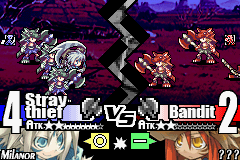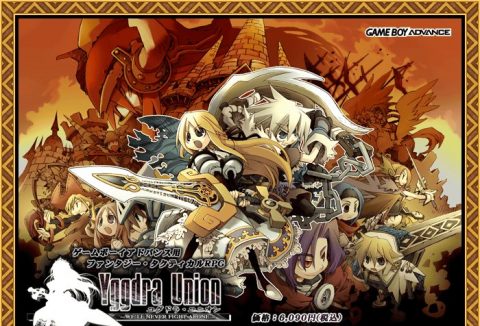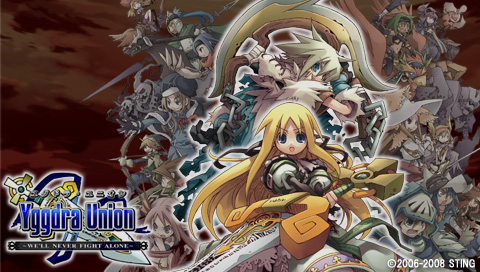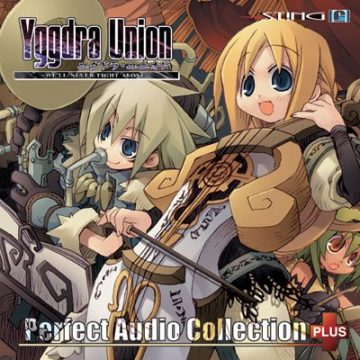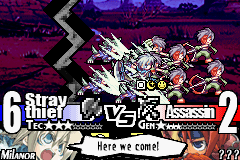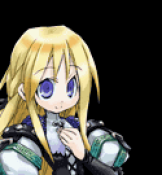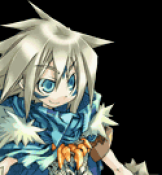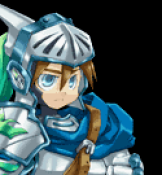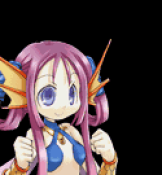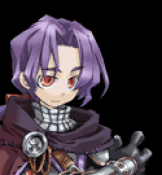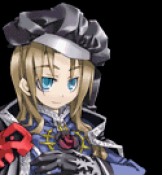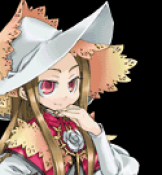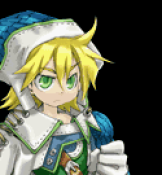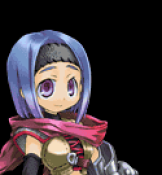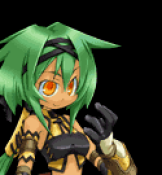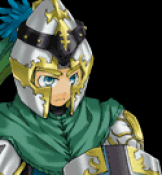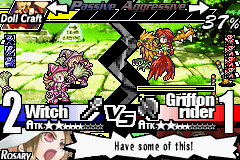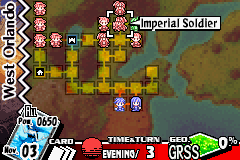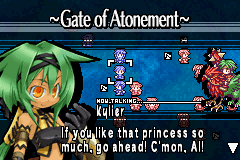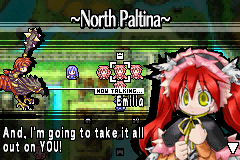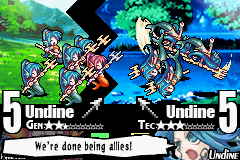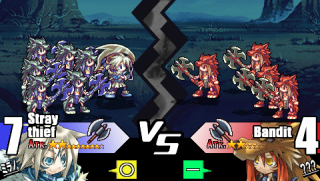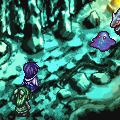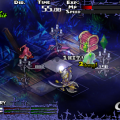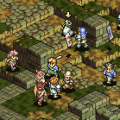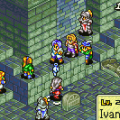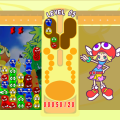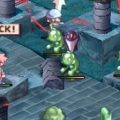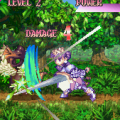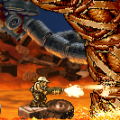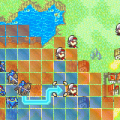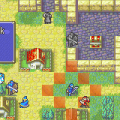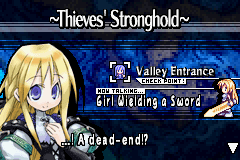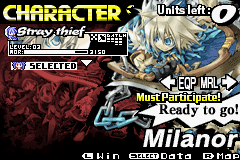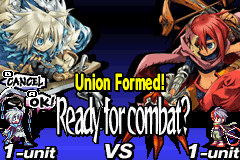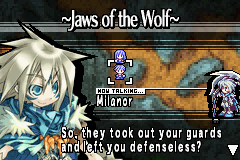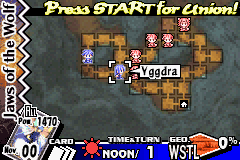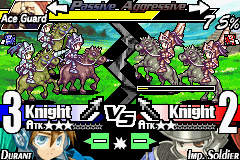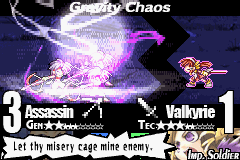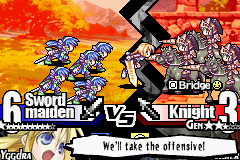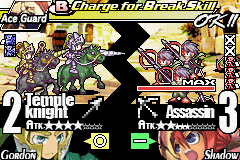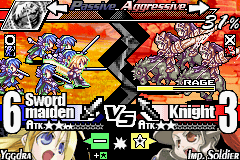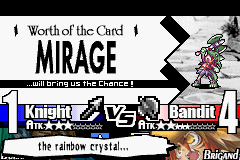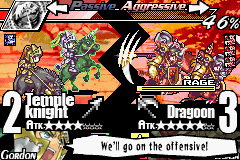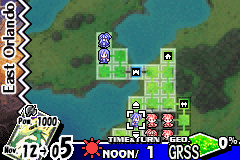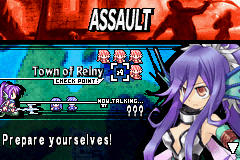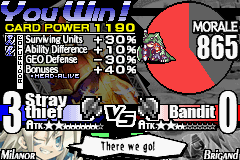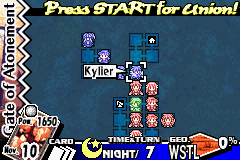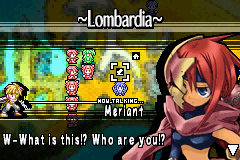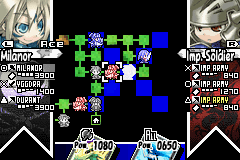Much like Riviera took the concept of the Japanese RPG and drastically reworked it, Yggdra Union begins with the basic mold of a tactical strategy RPG and gives it a good shakedown, resulting in a game that’s equal parts fresh and familiar. The best possible comparison is it’s a mixture of Fire Emblem and Ogre Battle, but even that does a disservice to Yggdra Union‘s innovations.
Although there’s a running story throughout the game – all introduced with overly long, boring cutscenes – it’s not horribly important. The game begins when the thief Milanor rescues a young princess in the woods, who’s being chased down by some rather nasty folks. Apparently the evil emperor Gulcasa has committed a coup d’tat and taken the throne for himself, with the only survivor being Princess Yggdra, who wields a sword of holy might. The rest of the game is spent building up your army and eventually taking back the throne from the vile usurper.
Characters
Yggdra
Princess Yggdra may look like a cutety pie, but she can hold her own in battle. Still, she’s a bit weak compared to your other characters, at least until later in the game. Her weapon of choice is a sword.
Milanor
Milanor is the true hero of the story, a wandering thief of stumbles upon Yggdra and agrees to help her out. He rends enemies with his axe.
Durant
Durant is a knight that accompanies Milanor and Yggdra at the beginning of the game. Like all knights, he rides on a horse and wields a spear.
Nietzsche
Most Japanese games that are based on some kind of mythology usually end up getting it wrong, but this is one of the most hilarious. Nietzsche (in real life) was a German philosopher who spoke of nihilism. Nietzsche (in the game) is a cutesy little girl undine (mermaid) who pokes gently with her spear.
Russell
Russell is an “astral fencer”. How odd. He’s one of the Five Dragon Generals and a fierce nemesis, but can be recruited if you convince him to switch sides.
Roswell
Not far in the game, you have to defuse a war between the Necromancer Roswell and the Witch Rosary. The one you ally with will join your party. He looks like a jerk – and kind of is.
Rosary
Rosary is quite stuck up, just like her nemesis Roswell, but she doesn’t look as stupid. Plus it’s much cooler to watch her witches coast on their brooms and wail on her foes.
Cruz
Cruz is a hunter/resistance leader under attack when Milanor and pals burst onto the scene to (hopefully) save him. His weapon of choice is a bow.
Elena
All throughout the game, Milanor and company are stalked by a duo of persistent bounty hunters. Elena is the meeker of the two, who eventually ends up aiding Yggdra’s cause. Like other assassins, she attacks with a bow and arrow.
Kylier
Kylier comes to Milanor’s aid at an early part of the story, but it’s not until much later that she joins. This fellow thief rides on griffons and also attacks with an axe.
By now, most video gamers should come to expect that Japanese RPGs will have somewhat cutesy designs, but Yggdra Union does take it a bit overboard. It’s hard to take Princess Yggdra seriously, what with those doe eyes and all, and the rest of the cast is so adorable that it’s pretty hilarious to see them beat each other to submission on the battlefield. Unlike something like, say, Disgaea, which is meant to be cute and humorous, Yggdra Union‘s plot is thoroughly solemn, much like your usual strategy RPG. The rest of the graphics are something of a mixed bags – the sprite work is a rare treat in this day and age, especially on something as tiny and meek at the Gameboy Advance, but the map screen is pixellated and messy, turning all of the visuals into a total eyesore outside of battle.
As mentioned before, Yggdra Union a few things from Fire Emblem, at least on the surface. You move your units on an overhead map and visit towns to gain items. Even the weapons triangle – Axe beats Sword, Sword beats Spear, Spear beats Axe – is identical. From there, the similarities end. Before you enter the battlefield, you’re given the option to choose a hand of cards. Mentioning “cards” in an RPG tends to through up a red flag in many games minds, as it seems to imply that luck is a major factor in winning, but no worries – there’s no randomization or anything of the sort. Each card determines how many movements your units can make in a turn, as well as your striking power and special abilities. Your movement allocation is divided amongst the entire party – when your card says you can move ten spaces. it means only ten spaces total, not per unit. Additionally, you can only attack once per turn. That may seem odd, but your can have other units join in attacks depending on their positions. If the lead attacker is female, all units vertically and horizontally adjacent within two squares will join in. If the lead attacker is male, all units in an X shape withing two square will attack. Naturally, the enemy has the same advantage. Before you get into battle, you can compare your units to your opponents and get an estimation of how the fight will turn out, depending on what kind of units are involved. When you finally get your units into formation, you form a “union” and battle begins.
One of Yggdra Union‘s greatest strength lies within its powerful presentation. The map screen music is your typical militaristic medieval type fanfare, but when you begin a union, this totally badass looping guitar theme begins blaring. When you start, a huge versus screen fades in, showing huge illustrations of the combatants and little sprites taunting each other in preparation for battle. This isn’t like Advance Wars where the two sides politely line up and exchange fire – the attacking side begins charging forward, leaps over the divider in the screen and delivers their first attack, hopefully sending at least a few of their opponents to their graves. The defenders deliver another strike, flinging the attackers back on the left side of the screen, and the two start clashing to their deaths. All of this is accompanied by some pulse pounding guitars that would make Mega Man X and his buddies jealous. Sure, the scratchy GBA synth tries as hard it as can to make the tunes sound crappy, but they’re still exciting, and you welcome every battle just to hear them again. And there’s a ton of variety too – each of the major player characters and enemies have their own themes, along with a number of generic bad guy tunes.
Before the music gets you too pumped up, you have to remember that you’re still kinda sorta in charge of the battle. This is where the similarities to Ogre Battle come in – you don’t directly control the outcome, but you can influence it. You can choose to put your warriors in offensive, defense, or neutral stances. Holding “right” on the d-pad will command them to attack aggressively, draining the power bar on the top of the screen. Holding “left” will lighten the attacks but causes the bar to fill up. When said power bar reaches maximum – and various conditions are met, including the characters involved and the time of day – you can use the special attack associated with the card you’ve chosen. Many of them are super powerful attacks, healing spells, or extra defensive capabilities, and include tons of random English tossed abound, much like Riviera. (And much like Riviera, they become a bit too long, and unfortunately cannot be skipped.) These can help turn the tide of battle if your particular battalion is underpowered.
When a unit loses, they don’t lose troops, but they do lose morale. If if you crush an enemy unit several times, as long as they have some morale left, they’ll still be just as powerful the next time they head into battle. Various forces – including the terrain, the card you’ve chosen, abilities used, and good old fashioned luck – can make increase the morale loss taken by the loser. When a friendly unit is killed, they’re removed from the battlefield for the duration of the map, although death is not permanent and they’ll come back in the next stage. They can also be resurrected with a certain ability.
In general, the maps in Yggdra Union are a bit smaller than other strategy games, leaving units to feel a bit cramped together. However, each scenario is usually comprised of two or three different parts, which usually open up new parts of the map once objectives are successfully completed. It also replenishes your card stock, which is definitely welcome – if you take too many turns and run out of cards, you lose the whole battle. Despite the pressure this might imply, it’s rare that this ever happens unless you really screw up.
However, there are other ways that you can mess yourself up. Many items are found by simply being on the right square at the right time, with no hints whatsoever. There are also hidden characters that are easily missable if you’re not paying attention or aren’t using a strategy guide. Since items are one of the only way to restore morale after battle, if you’re not careful, you can back yourself into a situation where your characters will begin battles on the brink of death. Not cool at all. Some of the stages can also get brutally difficult later on – although thankfully, when you retry a stage, much of the experience you accumulated during your first effort is carried over, and enemies seem to be weakened a bit too.
While Yggdra Union isn’t quite as fresh as Dragon Force was back in the days of the Saturn, it’s also so far removed from your standard Final Fantasy Tactics or Fire Emblem clone that it stands quite nicely on its own legs. While it was released at the end of the GBA life cycle and ignored by most (the nearly unpronouncable title doesn’t help), Yggdra Union is one of the finest strategy RPGs to come out in years, and by far the best game Sting has produced thus far.
The Japanese and English versions are nearly identical, save for one difference – much like the PSP version of Riviera, due to the crackdown of the CERO rating system, Sting covered up a bath scene featuring Yggdra. This scene is uncensored in the American version, although it’s still rating T by the ESRB, as it’s not even remotely explicit.
In 2008, Sting ported the game to the PlayStation Portable. Much like Riviera, this includes full voice acting and an arranged soundtrack. Mostly importantly, however, are the redrawn graphics. Riviera’s port was somewhat lazy since they just rescaled the existing sprites, but they’ve all been done from scratch, and the higher resolution of the PSP completely blows away the graphics from the GBA version. There are also a few new stages and a few new characters, including an older man named Bly, a girl named Astel and an angel named #367.
Screenshot Comparisons
Cutscene Comparisons
